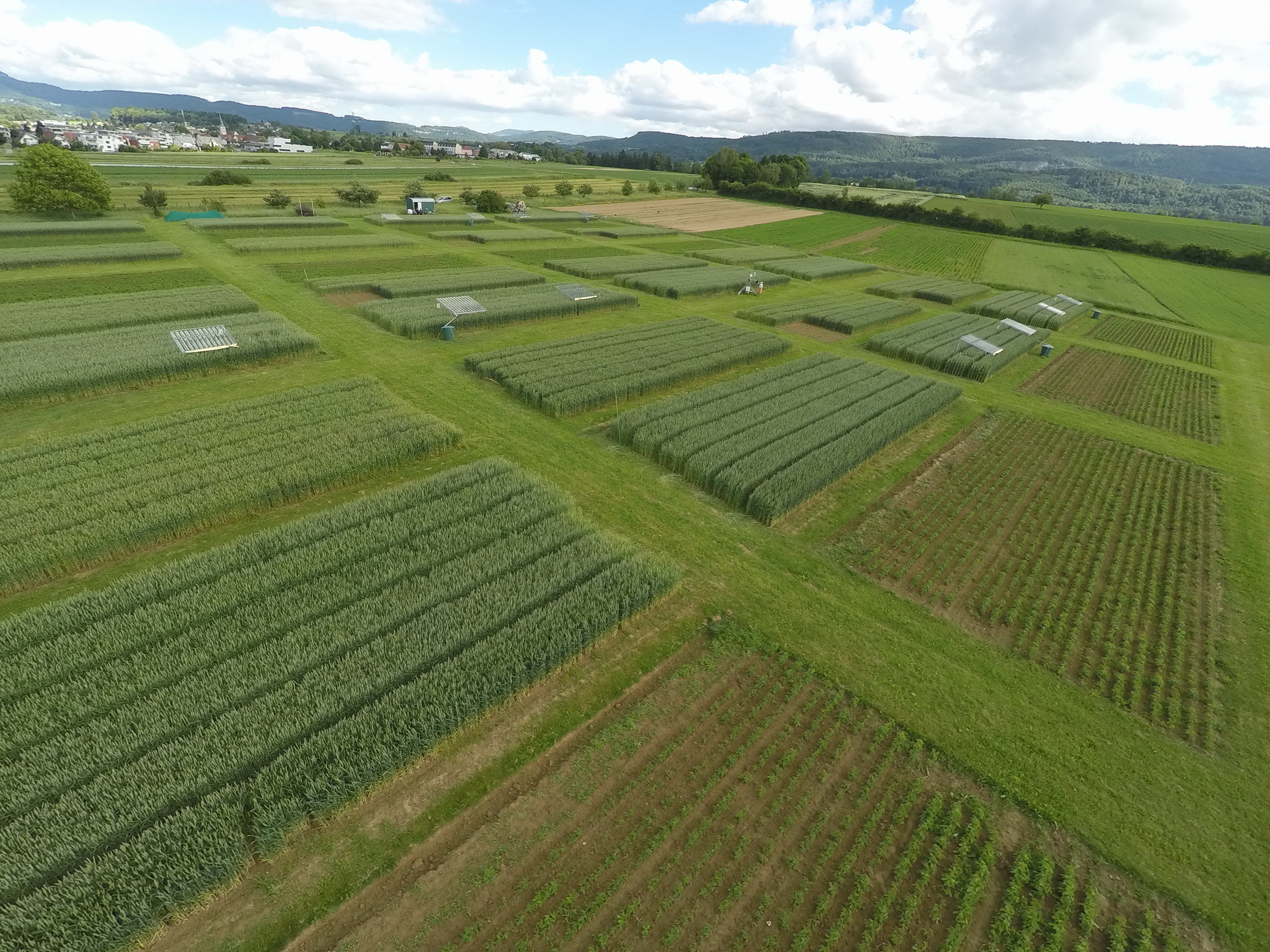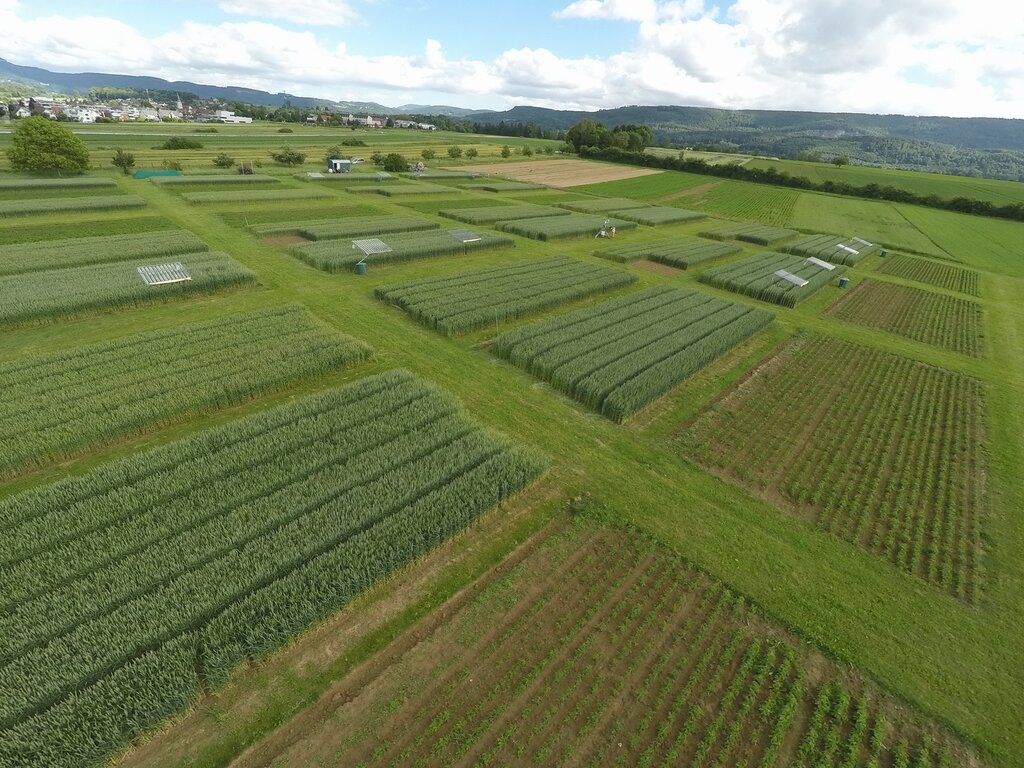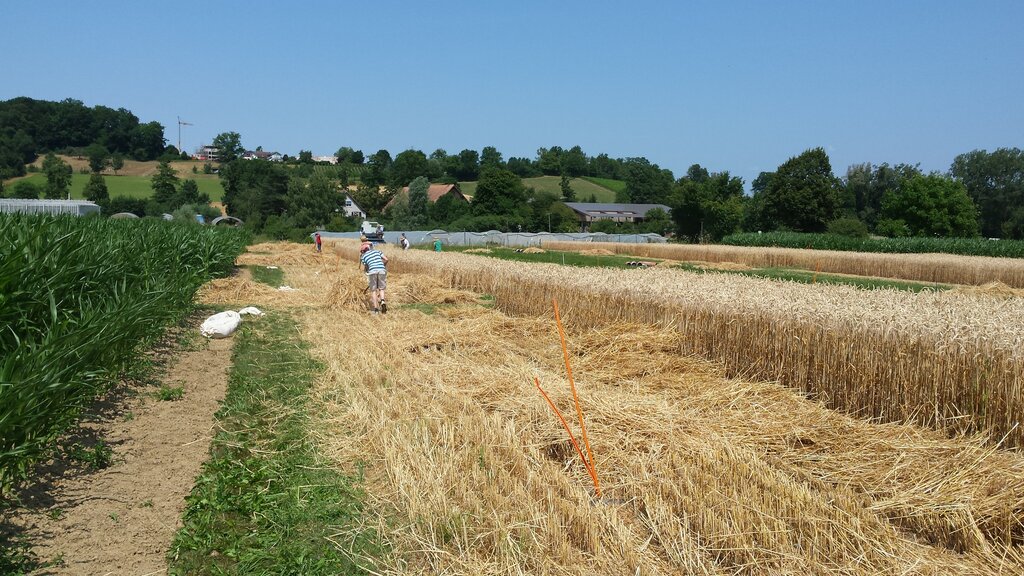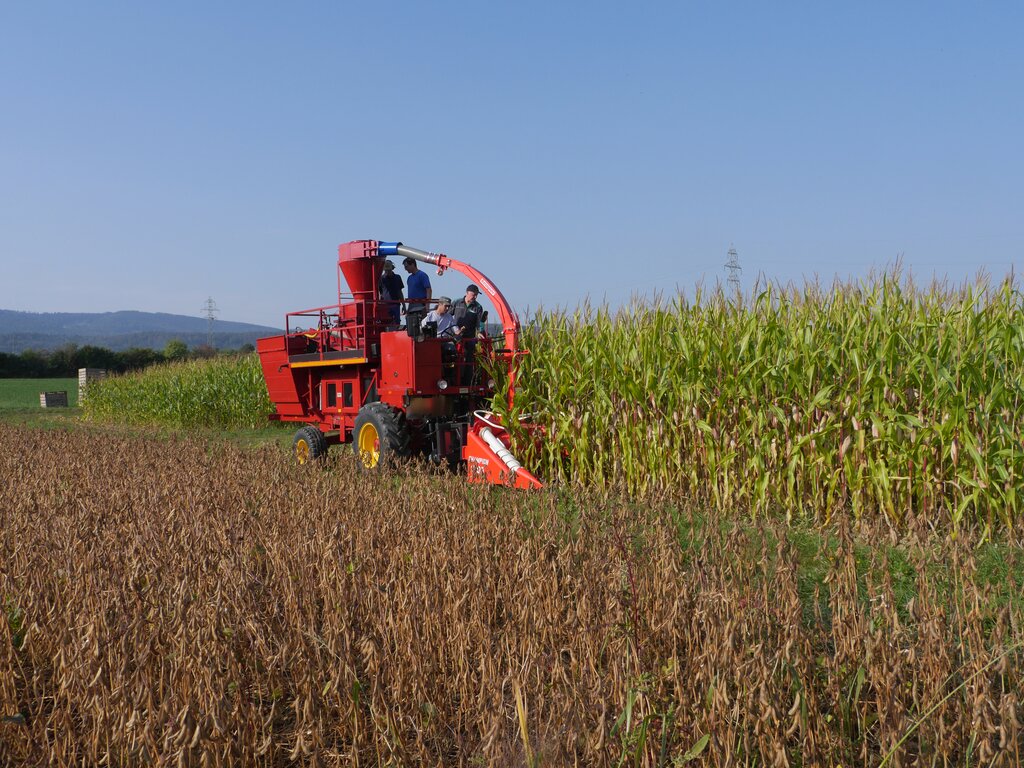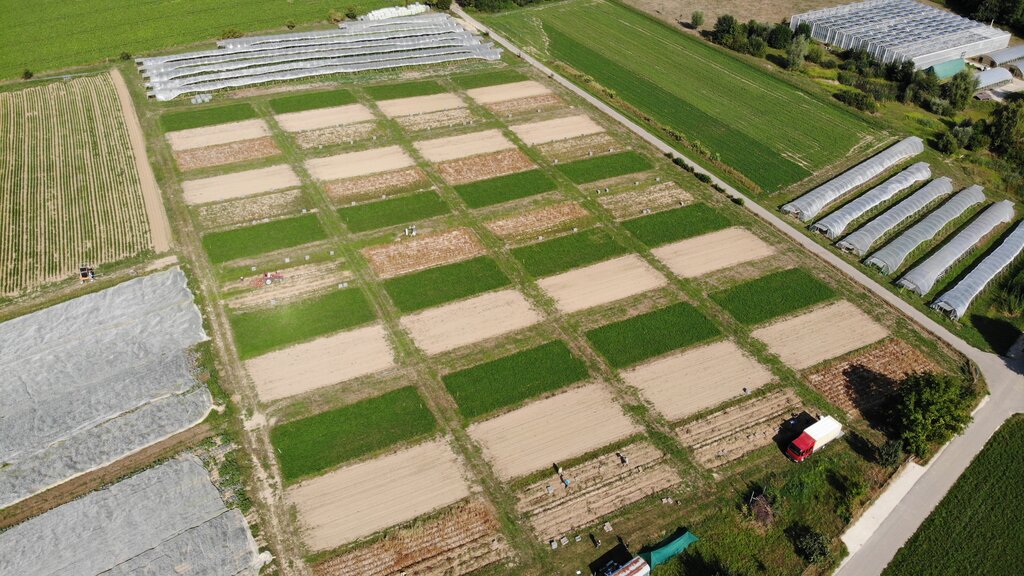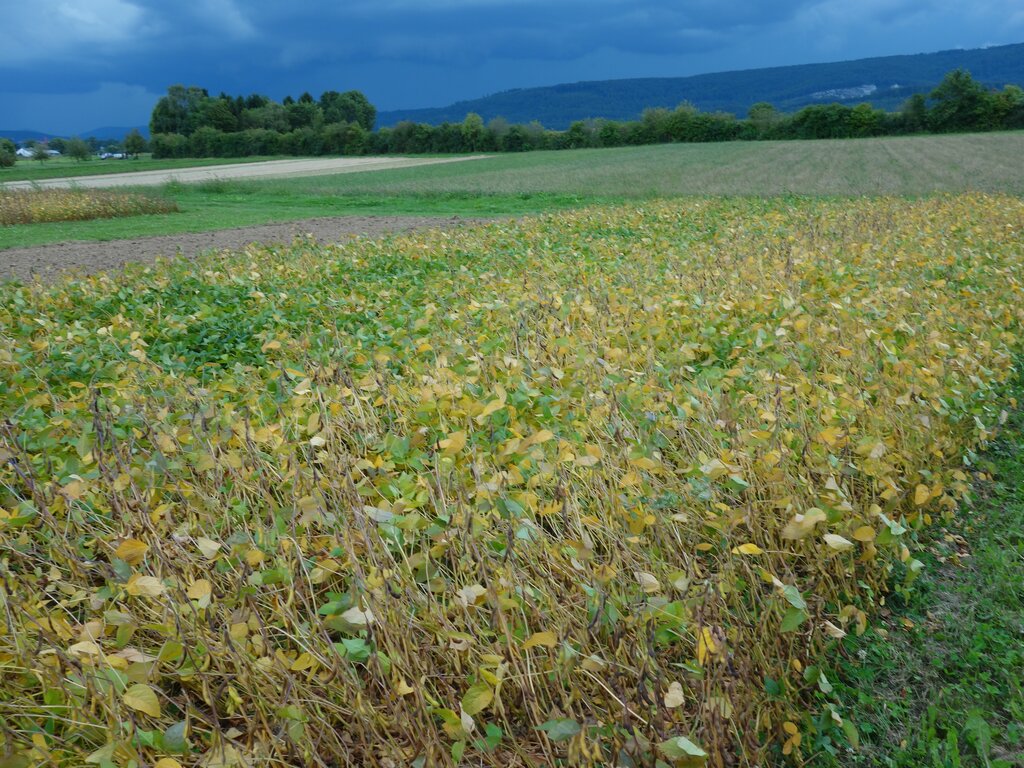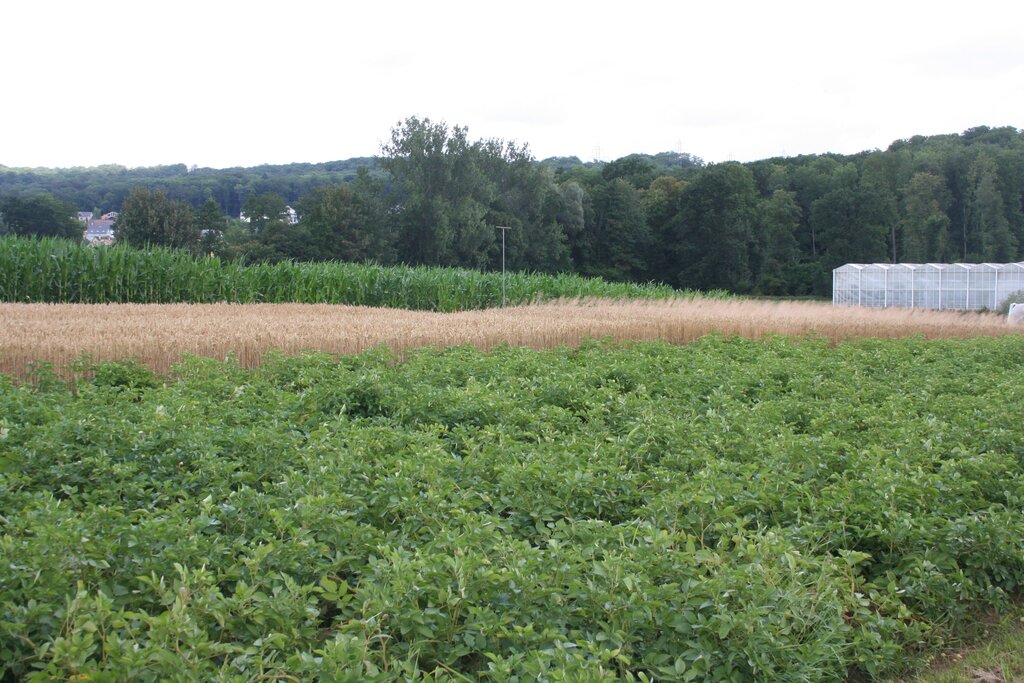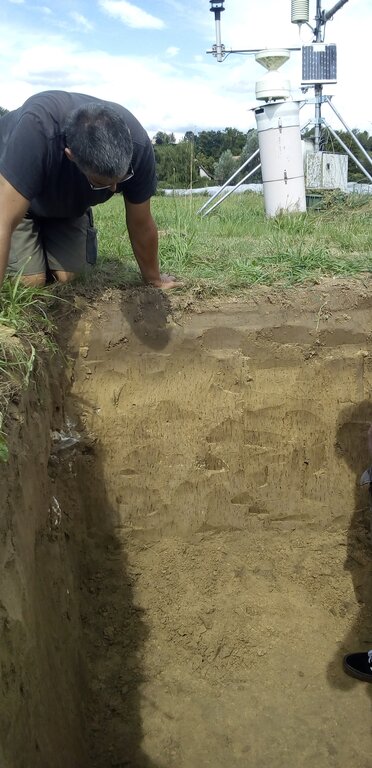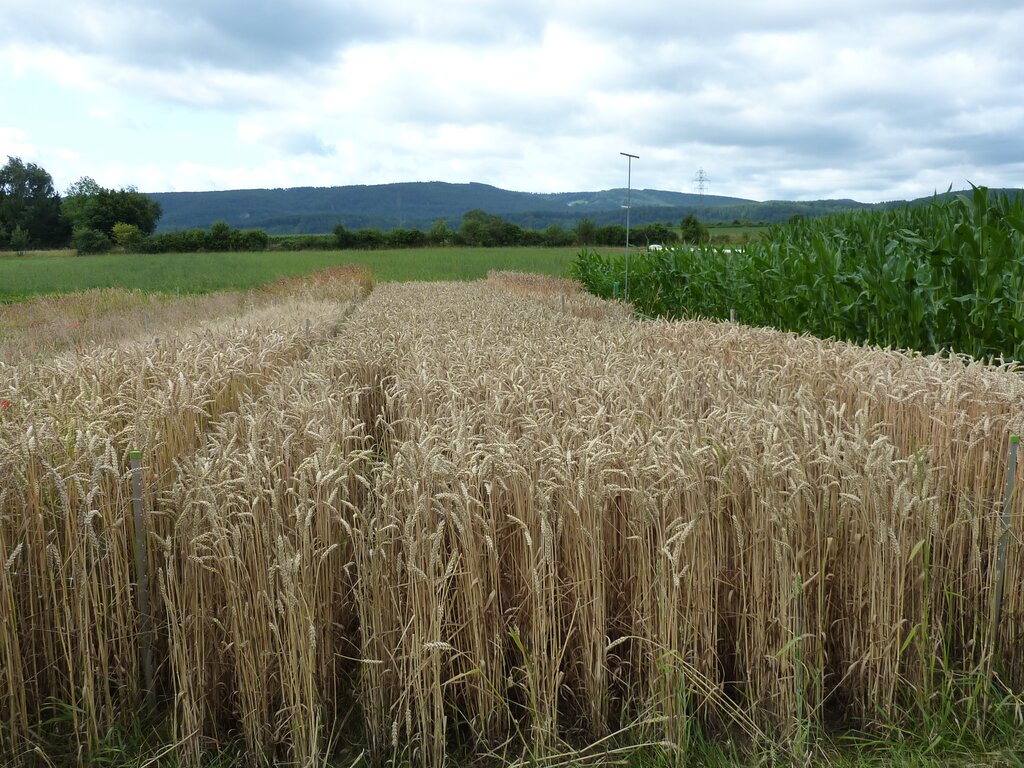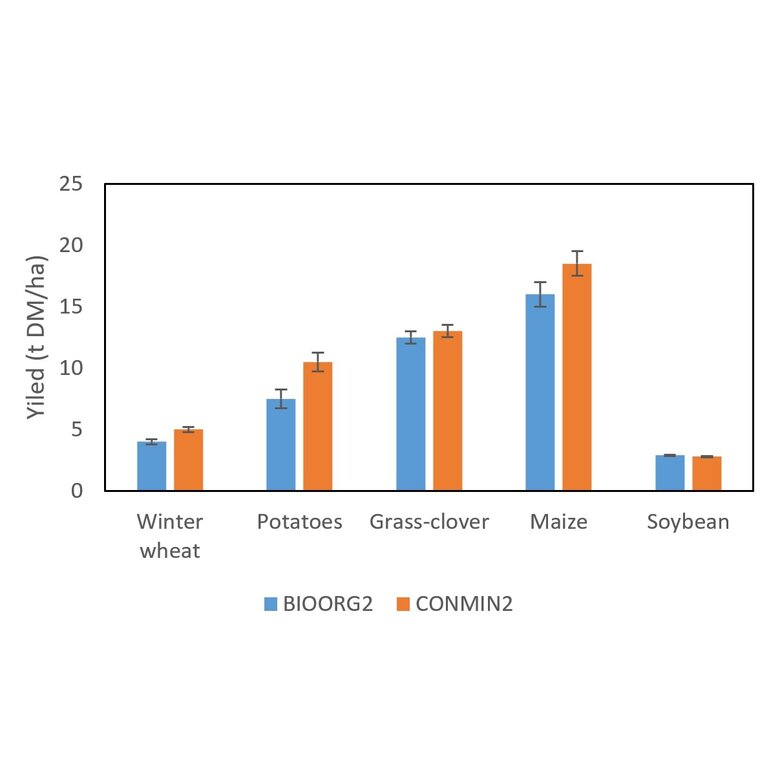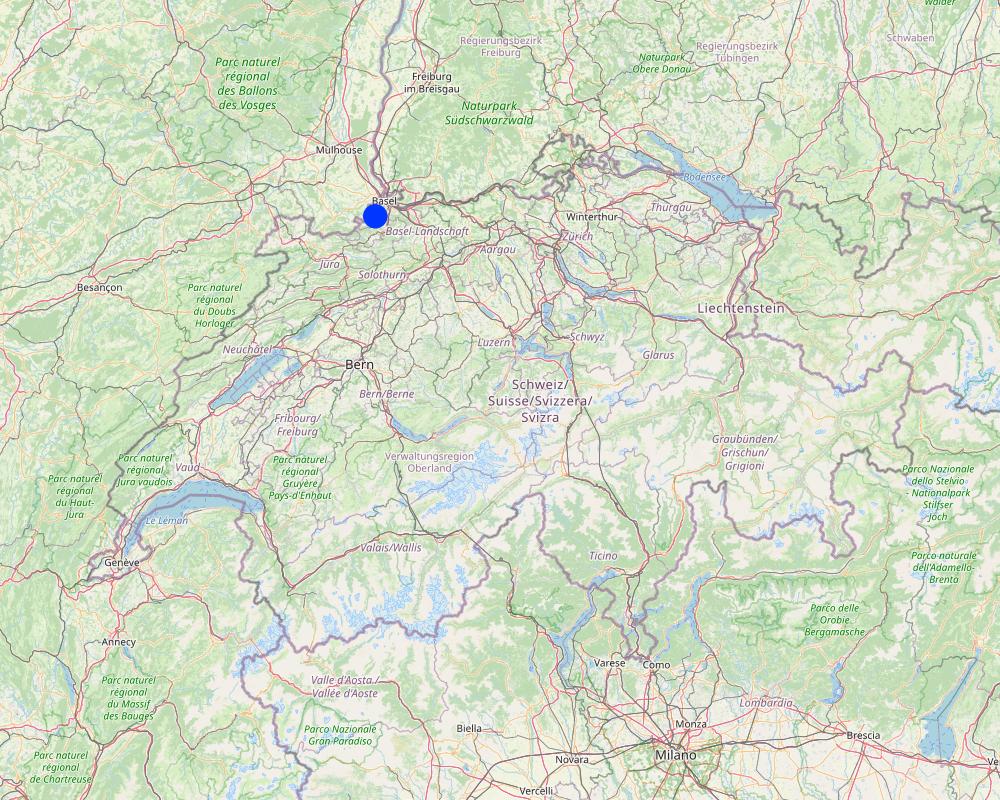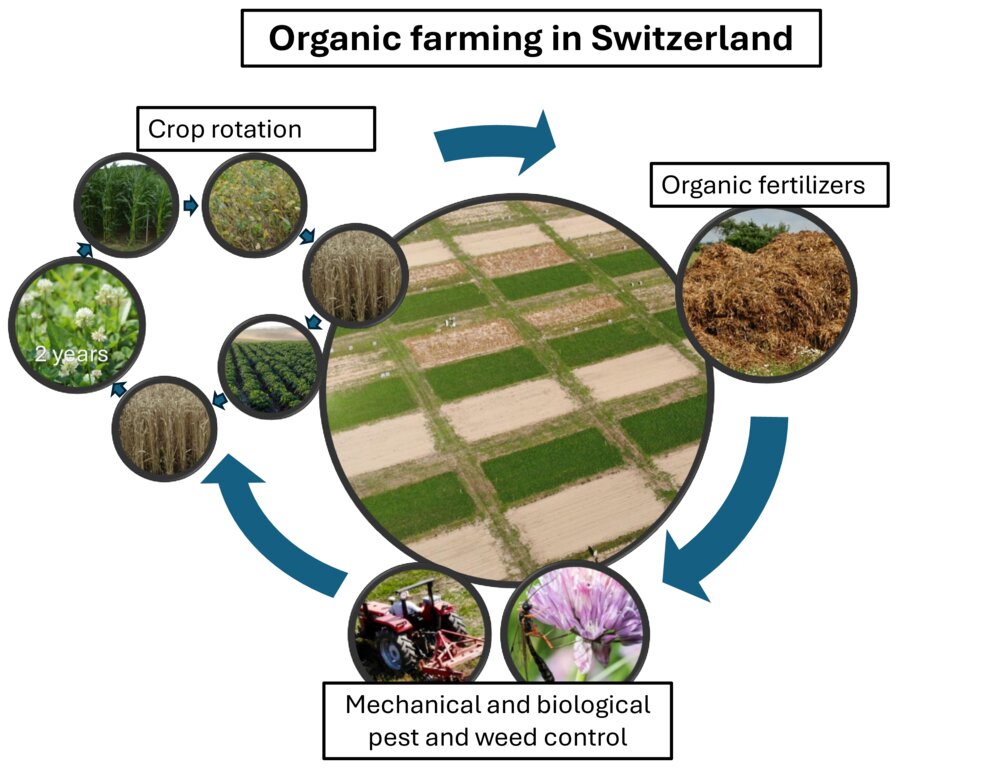Organic Agriculture (DOK Experiment) [Suíça]
- Criação:
- Atualização:
- Compilador/a: Moritz Laub
- Editores: Jochen Mayer, Hans-Martin Krause
- Revisores: Rima Mekdaschi Studer, William Critchley
Biologischer Landbau/ Biologische Landwirtschaft
technologies_7138 - Suíça
Veja as seções
Expandir tudo Recolher tudo1. Informação geral
1.2 Detalhes do contato das pessoas capacitadas e instituições envolvidas na avaliação e documentação da tecnologia
Especialista em GST:
Nome do projeto que facilitou a documentação/avaliação da Tecnologia (se relevante)
Land Use Based Mitigation for Resilient Climate Pathways (LANDMARC)Nome da(s) instituição(ões) que facilitou(ram) a documentação/ avaliação da Tecnologia (se relevante)
Research institut for organic agriculture (FiBL) - SuíçaNome da(s) instituição(ões) que facilitou(ram) a documentação/ avaliação da Tecnologia (se relevante)
Forschungsanstalt Agroscope Reckenholz-Tänikon ART (Forschungsanstalt Agroscope Reckenholz-Tänikon ART) - SuíçaNome da(s) instituição(ões) que facilitou(ram) a documentação/ avaliação da Tecnologia (se relevante)
ETH-Zürich (ETH-Zürich) - Suíça1.3 Condições em relação ao uso da informação documentada através de WOCAT
O/a compilador/a e a(s) pessoa(s) capacitada(s) aceitam as condições relativas ao uso de dados documentados através da WOCAT:
Sim
1.4 Declaração de sustentabilidade da tecnologia descrita
A tecnologia descrita aqui é problemática em relação a degradação da terra de forma que não pode ser declarada uma tecnologia de gestão sustentável de terra?
Não
2. Descrição da tecnologia de GST
2.1 Descrição curta da tecnologia
Definição da tecnologia:
Organic agriculture is a system of crop cultivation that uses biological methods of pest control and organic fertilizer as substitutes for chemical fertilizers and pesticides. It targets sustainability, enhancement of soil fertility, and biological diversity by aiming to close nutrient cycles while generally prohibiting synthetic pesticides, antibiotics, synthetic fertilizers, genetically modified organisms, and growth hormones.
2.2 Descrição detalhada da tecnologia
Descrição:
Organic agriculture is a globally applied technology practiced on agricultural land. It is carried out in 188 countries, with over 96 million hectares of agricultural land managed organically by at least 4.5 million farmers.
The main elements of this technology include the use of biological methods of pest control and organic fertilizer application, which replace chemical fertilizers and pesticides. It generally prohibits synthetic pesticides, antibiotics, synthetic fertilizers, genetically modified organisms, and growth hormones. The purpose of organic agriculture is to achieve sustainability in farming, enhancing soil fertility, increasing biological diversity and reducing the reliance on external inputs to agriculture, relying on nutrient recycling by applying manure and on biological nitrogen fixation from legumes. It also aims to provide a healthier and more environmentally friendly alternative to conventional farming practices. To establish and maintain organic agriculture, major activities include the application of organic fertilizers, crop rotation, and the use of pest-resistant plant varieties. Regular soil testing and monitoring of pest populations are also necessary. Certification of a farm as being officially organic is needed if the products are to be sold at a price premium.
Organic agriculture can improve soil health, reduce pollution of the surrounding environment, and contribute to biodiversity in the fields. Moreover, it can offer healthier food options and potentially higher income for farmers due to the premium prices of organic products. Land users appreciate organic agriculture for its environmental benefits and potential for higher income. However, some dislike the increased labour and time required, the 10-30% of reduction in yields, compared to conventional agriculture, as well as the need for a transition period before farms can be certified as organic and products sold at a premium price.
The DOK experiment presented here is representative of organic practices in the context of temperate regions (specifically, Switzerland and surrounding countries). It is jointly managed by the Research Institute of Organic Agriculture (FiBL), and by the Swiss Confederation's centre of excellence for agricultural research (Agroscope). The name "DOK Experiment" is derived from its main purpose, to compare three cultivation systems: Biodynamic (D), organic (O) and conventional (K) agriculture. These differ in terms of how they are fertilized (D: liquid manure, manure compost, biodynamic preparations; O: liquid manure, rotted manure; K: two variants, one with liquid manure, fresh or rotted manure, mineral fertilizer (CONFYM variant) and one with only mineral fertilizer (CONMIN variant)), as well as by plant protection (D and O: organic; K: chemical-synthetic). In addition to two fertilization levels of the three cultivation systems (half fertilization and standard practice fertilization), two controls are carried out, an unfertilized (N) and a purely mineral-fertilized variant (M). The experiment is spatially replicated four times. The results presented here refer to the conventional (K) and the organic (O) treatments at the standard practice fertilization level.
2.3 Fotos da tecnologia
Observações gerais sobre as fotos:
All photos are from the DOK experiment in Therwil.
2.4 Vídeos da tecnologia
Comentários, breve descrição:
DOK-Versuch: Biologische und konventionelle Landwirtschaft im Langzeitvergleich
https://www.youtube.com/watch?v=gDCLHxU0ijg
Data:
16/07/2014
Localização:
Therwil
Comentários, breve descrição:
Der DOK-Versuch - Eine Internationale Forschungsplattform (Juni 2015)
https://www.youtube.com/watch?v=QYBS4Qj7T14
Data:
16/06/2015
Localização:
Therwil
2.5 País/região/locais onde a tecnologia foi aplicada e que estão cobertos nesta avaliação
País:
Suíça
Região/Estado/Província:
Basel
Especificação adicional de localização:
Therwil
Especifique a difusão da tecnologia:
- Aplicado em pontos específicos/concentrado numa pequena área
O(s) local(is) tecnológico(s) está(ão) localizado(s) em uma área permanentemente protegida?
Não
Map
×2.6 Data da implementação
Indique o ano de implementação:
1978
2.7 Introdução da tecnologia
Especifique como a tecnologia foi introduzida:
- durante experiências/ pesquisa
Comentários (tipos de projeto, etc.):
This is a research site, investigating the benefits of organic agriculture.
3. Classificação da tecnologia de GST
3.1 Principal/principais finalidade(s) da tecnologia
- Reduz, previne, recupera a degradação do solo
- Preserva ecossistema
- Preservar/melhorar a biodiversidade
- Cria impacto social benéfico
3.2 Tipo(s) atualizado(s) de uso da terra onde a tecnologia foi aplicada
Uso do solo misturado dentro da mesma unidade de terra:
Não

Terra de cultivo
- Cultura anual
Cultivo anual - Especificar culturas:
- cereais - milho
- cereais - trigo (inverno)
- culturas forrageiras - trevo
- legumes e leguminosas - soja
- culturas de raiz/tubérculos- batatas
Sistema de cultivo anual:
Trigo ou rotação similar com feno/pasto
Número de estações de cultivo por ano:
- 1
O rodízio de culturas é praticado?
Sim
Caso afirmativo, especifique:
The typical crop rotation over the last three cycles was: silage maize, soybean, winter wheat, potato, winter wheat, and two years of grass-clover (Knapp et al. 2023).
3.3 O uso do solo mudou devido à implementação da Tecnologia?
O uso do solo mudou devido à implementação da Tecnologia?
- Não (Continuar com a pergunta 3.4)
3.4 Abastecimento de água
Abastecimento de água para a terra na qual a tecnologia é aplicada:
- Precipitação natural
3.5 Grupo de GST ao qual pertence a tecnologia
- sistema rotativo (rotação de culturas, pousios, cultivo itinerante)
- Gestão integrada plantação-criação de animais
- Gestão integrada de pragas e doenças (inclusive agricultura orgânica)
3.6 Medidas de GST contendo a tecnologia

Medidas agronômicas
- A2: Matéria orgânica/fertilidade do solo
- A5: Gestão de sementes, variedades melhoradas
- A6: Gerenciamento de resíduos
A6: Especificar o gerenciamento de resíduos:
A 6.4: retido
Comentários:
Comment to A5: It is aimed to use pest-resistant crop varieties, because chemical pesticides are not allowed in organic agriculture.
3.7 Principais tipos de degradação da terra abordados pela tecnologia

Deteriorização química do solo
- Cn: declínio de fertilidade e teor reduzido de matéria orgânica (não causado pela erosão)

Degradação biológica
- Bs: Qualidade e composição de espécies/declínio de diversidade
- Bl: perda da vida do solo
3.8 Redução, prevenção ou recuperação da degradação do solo
Especifique o objetivo da tecnologia em relação a degradação da terra:
- Prevenir degradação do solo
- Reduzir a degradação do solo
4. Especificações técnicas, implementação de atividades, entradas e custos
4.1 Desenho técnico da tecnologia
Especificações técnicas (relacionada ao desenho técnico):
A summary of the principles of organic farming in Switzerland
Autor:
Moritz Laub
Data:
26/06/2024
4.2 Informação geral em relação ao cálculo de entradas e custos
Especifique como custos e entradas foram calculados:
- por área de tecnologia
Indique o tamanho e a unidade de área:
ha
Se utilizar uma unidade de área local, indicar fator de conversão para um hectare (por exemplo, 1 ha = 2,47 acres): 1 ha =:
1 ha
Outro/moeda nacional (especifique):
CHF
Se for relevante, indique a taxa de câmbio do USD para moeda local (por exemplo, 1 USD = 79,9 Real): 1 USD =:
0,91
Indique a média salarial da mão-de-obra contratada por dia:
160-240
4.3 Atividades de implantação
| Atividade | Periodicidade (estação do ano) | |
|---|---|---|
| 1. | Courses on the principles of organic farming | Before transition |
| 2. | Transitioning period (already practicing but not yet certified) | 2 years |
| 3. | Certification | Start of year 3 |
Comentários:
Detailed information on the transition process and requirements can be found here:
https://www.fibl.org/de/shop/1001-umstellung
4.4 Custos e entradas necessárias para a implantação
Comentários:
Courses are needed when transitioning to organic agriculture. They usually take around a week and the cost of courses depends locally.
Further, there are costs for certification, which are usually 400 CHF.
The main costs of transitioning is lost yields in the years during transition, when there is no price premium, yet. Subsidies depend on the Swiss Canton.
Some detailed information on the cost associated with transition can be found here:
https://www.bioaktuell.ch/grundlagen/umstellung/allgemein/kosten-und-beitraege
4.5 Atividades recorrentes/manutenção
| Atividade | Periodicidade/frequência | |
|---|---|---|
| 1. | Application of manure | At least yearly |
| 2. | Application of slurry | Usually twice a year |
| 3. | Soil preparation by harrow or cultivator | Yearly |
| 4. | Weed supression by tine weeder | At least yearly |
| 5. | Biological pesticide application (e.g., Novodor) | When needed, mostly in potato |
| 6. | Planting of cover crop | After wheat |
| 7. | Mulching cover crop | Before planting soy/maize |
Comentários:
The measures here reflect the activities that are in addition to conventional management needs. Their exact sequence depends on selected crop rotation. In the DOK experiment is was silage maize, soybean, winter wheat, potato, winter wheat, and two years of grass-clover.
4.6 Custos e entradas necessárias pata a manutenção/atividades recorrentes (por ano)
| Especifique a entrada | Unidade | Quantidade | Custos por unidade | Custos totais por entrada | % dos custos arcados pelos usuários da terra | |
|---|---|---|---|---|---|---|
| Mão-de-obra | Labour requirements compared to conventional agriculture | % | 113,0 |
Comentários:
Because this is a research trial, the detailed costs are neither available nor would they be representative of typical organic farms. Therefore, it is best to rely on the estimated costs from an international study. Based on this study there are 13% higher labour costs in organic farming, but the higher labor cost in organic systems is offset by lower costs of purchased inputs. The total production cost is not different to conventional farming. When the actual organic premiums are considered, gross returns, benefit/cost ratios, and net present values are significantly higher for organic crops compared to conventional crops (21%, 24%, and 35%, respectively).
The study is available here:
https://www.doi.org/10.1073/pnas.1423674112
A good way to estimate the costs of organic vs conventional production is the KTBL Performance Cost calulator. It can be specified to farm and machinery size, soil type and has an option for organic agriculture to see the differences. (only in German language):
https://daten.ktbl.de/dslkrpflanze/postHv.html
4.7 Fatores mais importantes que afetam os custos
Descreva os fatores mais determinantes que afetam os custos:
Reduced yield without price premium during transition period.
5. Ambiente natural e humano
5.1 Clima
Precipitação pluviométrica anual
- <250 mm
- 251-500 mm
- 501-750 mm
- 751-1.000 mm
- 1.001-1.500 mm
- 1.501-2.000 mm
- 2.001-3.000 mm
- 3.001-4.000 mm
- > 4.000 mm
Especifique a média pluviométrica anual em mm (se conhecida):
840,00
Especificações/comentários sobre a pluviosidade:
Typical temperate climate. Rainfall is mostly evenly distributed throughout the year with slightly higher values in May, June, July and August.
Zona agroclimática
- úmido
5.2 Topografia
Declividade média:
- Plano (0-2%)
- Suave ondulado (3-5%)
- Ondulado (6-10%)
- Moderadamente ondulado (11-15%)
- Forte ondulado (16-30%)
- Montanhoso (31-60%)
- Escarpado (>60%)
Formas de relevo:
- Planalto/planície
- Cumes
- Encosta de serra
- Encosta de morro
- Sopés
- Fundos de vale
Zona de altitude:
- 0-100 m s.n.m.
- 101-500 m s.n.m.
- 501-1.000 m s.n.m.
- 1.001-1.500 m s.n.m.
- 1.501-2.000 m s.n.m.
- 2.001-2.500 m s.n.m.
- 2.501-3.000 m s.n.m.
- 3.001-4.000 m s.n.m.
- > 4.000 m s.n.m.
Indique se a tecnologia é aplicada especificamente em:
- Não relevante
5.3 Solos
Profundidade do solo em média:
- Muito raso (0-20 cm)
- Raso (21-50 cm)
- Moderadamente profundo (51-80 cm)
- Profundo (81-120 cm)
- Muito profundo (>120 cm)
Textura do solo (solo superficial):
- Médio (limoso, siltoso)
Textura do solo (>20 cm abaixo da superfície):
- Médio (limoso, siltoso)
Matéria orgânica do solo superficial:
- Médio (1-3%)
5.4 Disponibilidade e qualidade de água
Lençol freático:
5-50 m
Disponibilidade de água de superfície:
Bom
Qualidade da água (não tratada):
Água potável boa
A qualidade da água refere-se a:
águas subterrâneas
A salinidade da água é um problema?
Não
Ocorre inundação da área?
Não
5.5 Biodiversidade
Diversidade de espécies:
- Médio
Diversidade de habitat:
- Médio
5.6 Características dos usuários da terra que utilizam a tecnologia
Sedentário ou nômade:
- Sedentário
Orientação de mercado do sistema de produção:
- Comercial/mercado
Rendimento não agrícola:
- 10-50% de toda renda
Nível relativo de riqueza:
- Média
Indivíduos ou grupos:
- Indivíduo/unidade familiar
Nível de mecanização:
- Mecanizado/motorizado
Gênero:
- Mulheres
- Homens
Idade dos usuários da terra:
- meia-idade
5.7 Área média de terrenos utilizados pelos usuários de terrenos que aplicam a Tecnologia
- < 0,5 ha
- 0,5-1 ha
- 1-2 ha
- 2-5 ha
- 5-15 ha
- 15-50 ha
- 50-100 ha
- 100-500 ha
- 500-1.000 ha
- 1.000-10.000 ha
- > 10.000 ha
É considerado pequena, média ou grande escala (referente ao contexto local)?
- Média escala
Comentários:
Area refers to typical users (not the DOK Experiment)
5.8 Propriedade de terra, direitos de uso da terra e de uso da água
Propriedade da terra:
- Indivíduo, intitulado
Direitos do uso da terra:
- Arrendado
- Indivíduo
- irrigation not common
Os direitos de uso da terra são baseados em um sistema jurídico tradicional?
Não
5.9 Acesso a serviços e infraestrutura
Saúde:
- Pobre
- Moderado
- Bom
Educação:
- Pobre
- Moderado
- Bom
Assistência técnica:
- Pobre
- Moderado
- Bom
Emprego (p. ex. não agrícola):
- Pobre
- Moderado
- Bom
Mercados:
- Pobre
- Moderado
- Bom
Energia:
- Pobre
- Moderado
- Bom
Vias e transporte:
- Pobre
- Moderado
- Bom
Água potável e saneamento:
- Pobre
- Moderado
- Bom
Serviços financeiros:
- Pobre
- Moderado
- Bom
6. Impactos e declarações finais
6.1 Impactos no local mostrados pela tecnologia
Impactos socioeconômicos
Produção
Produção agrícola
Quantidade anterior à GST:
Mean wheat yield of 5 t DM/ha
Quantidade posterior à GST:
Mean wheat yield of 4 t DM/ha
Comentários/especificar:
Other mean yields of organic treatment (BIOORG2 with 1.4 livestock units):
Potatoes: 7.5 t DM/ha
Soybean: 2.8 t DM/ha
Other mean yields of conventional treatment with only mineral fertilizer(CONMIN2):
Potatoes: 10 t DM/ha
Soybean: 2.8 t DM/ha
Produção de forragens
Quantidade anterior à GST:
Grass-clover: 13 t DM/ha
Quantidade posterior à GST:
Grass-clover: 12.5 t DM/ha
Comentários/especificar:
Other mean yields of organic treatment (BIOORG2 with 1.4 livestock units):
Maize silage: 17 t DM/ha
Other mean yields of conventional treatment with only mineral fertilizer(CONMIN2):
Maize silage: 19 t DM/ha
Renda e custos
Despesas com insumos agrícolas
Comentários/especificar:
Refers to overall organic agriculture in Switzerland (not DOK experiment)
Rendimento agrícola
Comentários/especificar:
Refers to overall organic agriculture in Switzerland (not DOK experiment)
Diversidade de fontes de rendimento
Comentários/especificar:
Refers to overall organic agriculture in Switzerland (not DOK experiment)
Carga de trabalho
Comentários/especificar:
Refers to overall organic agriculture in Switzerland (not DOK experiment)
Impactos ecológicos
Solo
Matéria orgânica do solo/carbono abaixo do solo
Quantidade anterior à GST:
About 1.3% SOC in the mineral fertilizer treatment in 2020
Quantidade posterior à GST:
About 1.6% SOC in the organic agriculture treatment in 2020
Comentários/especificar:
Organic treatment refers to BIOORG2 with 1.4 livestock units. Conventional treatment to the one with only mineral fertilizer (CONMIN2).
Acidez
Quantidade anterior à GST:
pH of 6.3 in the mineral fertilizer treatment in 2020
Quantidade posterior à GST:
pH of 6.5 in the organic agriculture treatment in 2020
Comentários/especificar:
Organic treatment refers to BIOORG2 with 1.4 livestock units. Conventional treatment to the one with only mineral fertilizer (CONMIN2).
Especificar a avaliação dos impactos no local (medidas):
All presented results are from published studies about the DOK experiment.
6.2 Impactos externos mostrados pela tecnologia
Poluição de água subterrânea/rio
Greenhouse gas emissions per land area
Comentários/especificar:
Based on a recent modeling study, emissions were between 0.5 to 1 t CO2 equivalent less per ha and year in organic compared to conventional agriculture in Switzerland (https://doi.org/10.1016/j.agsy.2020.102822).
Greenhouse gas emissions per calorie
Comentários/especificar:
In contrast to emissions per land area, it has been found that due to the lower yields there is little difference in terms of emissions per unit of food produced (https://doi.org/10.1088/1748-9326/aa6cd5).
Especificar a avaliação dos impactos fora do local (medidas):
There are ongoing debates on whether organic agriculture really leads to lower emissions than conventional agriculture, and the conclusion largely depends on the unit of reference (amount of food vs. per ha).
6.3 Exposição e sensibilidade da tecnologia às mudanças climáticas graduais e extremos/desastres relacionados ao clima (conforme o ponto de vista dos usuários da terra)
Mudança climática gradual
Mudança climática gradual
| Estação do ano | aumento ou diminuição | Como a tecnologia lida com isso? | |
|---|---|---|---|
| Temperatura anual | aumento | bem | |
| Precipitação pluviométrica sazonal | verão | redução/diminuição | bem |
Extremos (desastres) relacionados ao clima
Desastres climatológicos
| Como a tecnologia lida com isso? | |
|---|---|
| Seca | moderadamente |
Comentários:
Preliminary results from rain-emission shelters indicates similar resilience of the organic agriculture treatment as the conventional ones to drought.
However, organic agriculture in general is expected to better cope with climate change than conventional agriculture (https://www.fibl.org/fileadmin/documents/shop/1500-climate-change.pdf)
6.4 Análise do custo-benefício
Como os benefícios se comparam aos custos de implantação (do ponto de vista dos usuários da terra)?
Retornos a curto prazo:
negativo
Retornos a longo prazo:
positivo
Como os benefícios se comparam aos custos recorrentes/de manutenção(do ponto de vista dos usuários da terra)?
Retornos a curto prazo:
levemente positivo
Retornos a longo prazo:
levemente positivo
Comentários:
The main establishment costs is that in the first years of establishment, farmers have to apply all organic principles and thus have lower yields. However, certification as organic produce, which receive price premiums, is only possible 1-3 years after establishment, depending on the farm type. Thus, there is a period in which the lower yields are not yet compensated by a price premium. Once the system is certified and a price premium received, gross returns, benefit/cost ratios, and net present values are significantly higher for organic crops compared to conventional crops (https://www.doi.org/10.1073/pnas.1423674112)
6.5 Adoção da tecnologia
- 11-50%
Se disponível, determine a quantidade (número de unidades familiares e/ou área abordada):
About 16% of all farms in Switzerland are currently organic. (BAFU; https://www.bfs.admin.ch/news/de/2024-0392)
De todos aqueles que adotaram a Tecnologia, quantos o fizeram espontaneamente, ou seja, sem receber nenhum incentivo/ pagamento material?
- 51-90%
Comentários:
Switzerland has specific subsidies for those that practice organic farming but also many subsidies that all farmers receive. It is thus not 100% clear how many farmers were mainly incentivized by the additional subsidies. However, most become organic farmers out of conviction that it is the better and more sustainable farming system.
6.6 Adaptação
A tecnologia foi recentemente modificada para adaptar-se as condições variáveis?
Não
6.7 Pontos fortes/vantagens/oportunidades da tecnologia
| Pontos fortes/vantagens/oportunidades na visão do usuário da terra |
|---|
| Higher income due to price premiums |
| Less dependance on external inputs |
| Pontos fortes/vantagens/oportunidades na visão do/a compilador/a ou de outra pessoa capacitada |
|---|
| Better nutrient cycling and soil fertility. |
6.8 Pontos fracos, desvantagens/riscos da tecnologia e formas de superá-los
| Pontos fracos/vantagens/riscos na visão do/a compilador/a ou de outra pessoa capacitada | Como eles podem ser superados? |
|---|---|
| Lower yields compared to conventional agriculture. | Price premium. Eating less meat, which consumes most of the agricultural produce. |
7. Referências e links
7.1 Métodos/fontes de informação
- entrevistas com especialistas em GST
6
- compilação de relatórios e outra documentação existente
Quando os dados foram compilados (no campo)?
27/02/2019
Comentários:
Date of most recent soil sampling
7.2 Referências às publicações disponíveis
Título, autor, ano, ISBN:
Knapp, S., Gunst, L., Mäder, P., Ghiasi, S., Mayer, J., 2023. Organic cropping systems maintain yields but have lower yield levels and yield stability than conventional systems – Results from the DOK trial in Switzerland. Field Crops Research 302, 109072.
Disponível de onde? Custos?
For free: https://doi.org/10.1016/j.fcr.2023.109072
Título, autor, ano, ISBN:
Krause, H.-M., Stehle, B., Mayer, J., Mayer, M., Steffens, M., Mäder, P., Fliessbach, A., 2022. Biological soil quality and soil organic carbon change in biodynamic, organic, and conventional farming systems after 42 years. Agron. Sustain. Dev. 42, 117.
Disponível de onde? Custos?
For free: https://doi.org/10.1007/s13593-022-00843-y
Título, autor, ano, ISBN:
Mayer, M., Krause, H.-M., Fliessbach, A., Mäder, P., Steffens, M., 2022. Fertilizer quality and labile soil organic matter fractions are vital for organic carbon sequestration in temperate arable soils within a long-term trial in Switzerland. Geoderma 426, 116080.
Disponível de onde? Custos?
For free: https://doi.org/10.1016/j.geoderma.2022.116080
Título, autor, ano, ISBN:
Crowder, D.W., Reganold, J.P., 2015. Financial competitiveness of organic agriculture on a global scale. Proceedings of the National Academy of Sciences 112, 7611–7616.
Disponível de onde? Custos?
For free: https://doi.org/10.1073/pnas.1423674112
7.3 Links para informações on-line relevantes
Título/ descrição:
FIBL Webpage DOK trials
URL:
https://www.fibl.org/en/themes/projectdatabase/projectitem/project/404
7.4 Comentários gerais
Costs are the most difficult to estimate from agricultural experiments (not real field conditions)
Links e módulos
Expandir tudo Recolher tudoLinks
Não há links
Módulos
Não há módulos


